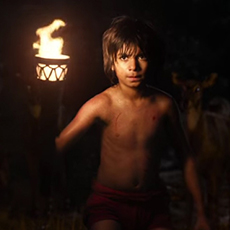DisneyToon Studios (February 14 2003), Walt Disney Home Entertainment (June 10 2003), single disc, 72 mins plus supplements, 1.66:1 anamorphic widescreen, Dolby Digital 5.1 and DTS Surround, Rated G, Retail: $29.99
Storyboard:
As this new Jungle Book begins, we find Mowgli recapping the story of the first film in an imaginative sequence using silhouetted figures. This quickly dealt with, we are introduced to the man-cub’s new family, who obviously care for the boy, but seem to have deemed him not suitable enough to wear clothes (he’s stuck with not even a new loincloth to replace the one from the first movie). As it turns out, Mowgli’s none too happy living in the man village, and longs for the freedom and fun of his old jungle life with cool bear buddy Baloo. On the other side of the fence, Baloo is feeling the same and breaks into the village at night to see his old pal. Soon Baloo is causing too much of a fuss and as the village wakes, the bear and the boy make their way for the main gate and disappear into the jungle.
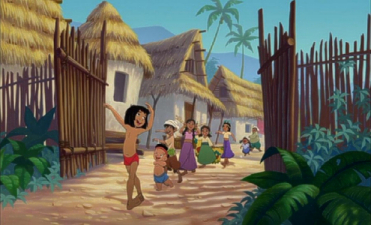
They’re back to their old ways right off, and ignoring the views of Bagheera, continue to party, not realising that Mowgli’s nemesis Shere Kahn the tiger, is back in these here parts looking for revenge. When he hears about the man-cub’s return to the jungle, the stage is set for another showdown between the good guys and the big bad cat. Meanwhile, Shanti, the young girl who lured Mowgli into the man village in the first place, and her family have taken to the jungle to look for Mowgli, placing themselves in danger. When Shanti and her brother Ranjan become separated from the other humans, Mowgli has to decide whether or not to hide deeper in the jungle or go back and help his new family from an inevitable meeting with Shere Kahn…
The Sweatbox Review:
Disney DTV strikes again as The Jungle Book 2 hit theaters at the beginning of 2003 and now comes to disc, right where it really belongs. For many critics, this was an unnecessary sequel (it actually feels more like a remake) and on the whole it got a drudging in the theatrical review press. I myself am not a big fan of these sequels, though the one that did previously make it to the big screen, the Peter Pan follow-on Return To Never-Land, surprised me with its depth, attention to detail and respect for the original. No such joy here, with this “Book” playing more as a straight rehash of the first, but with none of the infectious spirit that the boys in 1967 were able to bring to the story. But let’s not get caught up in the disappointment, as there are some moments worth visiting in Jungle Book 2, and on it’s rightful home on disc it should play well to the kids market and is guaranteed to please the little ones for an hour or so.
Now, and to be honest, I have never been the hugest of fans of the 1968 original film. The first half is fantastic – grand storytelling told in epic, broad strokes – but after the Bare Necessities/I Wanna Be Like You one-two punch half way through, things tail off rather flatly until the final showdown with Shere Kahn. This new film works in just the same way, and once Mowgli finds himself back in the jungle, the film basically reworks the original film’s story arc, shoehorning in the new “plot” elements. Two screenwriters are credited, as well as a dozen or so “additional material” writers, but did it really take all that many staff to outline this story? I’ve never read Rudyard Kipling’s own book sequel The Second Jungle Book, but surely that would have been a better place to start? Or even with the outlines designed by the original Nine Old Men for a sequel after the first film’s runaway success in 1968? At least Kipling isn’t credited with this story, but on the other hand, he is rather disrespectably not credited for the characters or inspiration at all!
The film never attempts to rise from its original concept and reason for being (to essentially make a quick buck) and never thrills or surprises, feeling less like a true Jungle Book 2 and rather more simply as a Jungle Book Again, being “different, but the same”. Interestingly, as I sat through the end credits, this film is credited not to Disney Television Animation, as most of the recent DTV and other sequels have been, but to DisneyToon Studios. Could this be a return to the Disney MovieToon concept, which was basically initiated to bring low-budget feature-length movies to the big screen? They were off to a good start with the DuckTales and Goofy movies, but seem to have lost their way with the video released films. Jungle Book 2 falls somewhere in between, not lowering itself to the depths of the quite frankly awful Cinderella, Atlantis or Tarzan And Jane sequels, but no-where near the strength of a Lilo And Stitch, Treasure Planet, the original Jungle Book, or even the Never-Land film.

While the animation is serviceable, the character lip synch isn’t as good as in recent Disney films. There are some nice animation shots during the Shere Kahn/night-time scenes, but overall the animation doesn’t have any real zip or zinger. The smooth moves of Ollie Johnston and Frank Thomas’ Baloo are substituted for an abrupt, stiff creation. The last remaining of Walt’s original Nine Old Men at the time of production, why weren’t Thomas and Johnson consulted? At least they could have told the new artists that there wasn’t going to be any point trying to follow their film up!
There was a great featurette on the 30th Anniversary LaserDisc set of the 1968 film during which Johnston and Thomas discussed and demonstrated just why Baloo works the way he does in animation. It seems the artists on this film either didn’t see this footage, or completely blocked it out! Overall the animation of the classic characters is more “angular”, with the most effective life being given to the newer, secondary characters: Lucky the vulture and King Louis’s hitherto-sidekick monkey pal, and the computer-aided production removes the Xerox-process artists’ lines – the very things that brought the characters to life – and creates a slightly sterile look (the thick black lines that define them don’t help either).
This surprising ignorance of the original seeps over into the music as well. One of Disney’s most memorable scores, The Jungle Book contained a number of great tunes and is still one of the most popular soundtracks today. The songs in Jungle Book 2, such as they are, don’t really amount to much, and even though the Sherman Brothers are still around and still producing (last at Disney’s with The Tigger Movie and on stage with the new, lengthier Chitty Chitty Bang Bang), they were not asked to contribute to the new film. Coming on board again to provide the music after his actually none-too-bad-at-all efforts on Return To Never-Land is Joel McNeely, the one person who seems to be trying to evoke the memories of the original and does as best a job he can with what he has to work with. Although the songs go for the big-band approach, his score relies more on the orchestral sound of the first film, and Mowgli’s soft reprise of the toe-tapping Jungle Rhythm felt as if it could have been straight from a discarded recording from 1968.
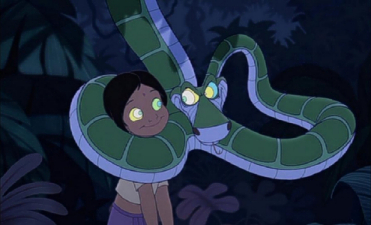
As for the voices, the new actors at least bring justice to their roles. As Baloo, Disney stalwart John Goodman deepens his voice a little to try and reach the gravely tones of the great Phil Harris and is probably a casting decision the Studio would have gone with even if Ed Gilbert, the voice of Baloo on Tale Spin, was still around. Child-star Hayley Joel Osment does fine as Mowgli, giving the character his all, even if he doesn’t quite sound like his predecessors (the original Mowgli was a combination of three voice actors, among them director Woolie Reitherman’s two sons). Mowgli sounds a little more grown up and self-assured this time around, and is perhaps a good thing, seeing as this should be taking place a few months down the line from events in the original.
Another Disney favorite, Tony Jay, appears again here as Shere Kahn, picking up right where George Sanders left off. His rumbling British-villain (heard in other such features as Hunchback and Treasure Planet) evokes the character quite well, though script wise he has none of the irony that Sanders brought to the tiger’s part. One character that certainly doesn’t make an appearance is King Louis of the apes himself. Due to a long-running legal wrangle between Disney and original voice Louis Prima’s wife, the Studio has decided to drop the character from any future projects altogether rather than pay her each time he is used (she maintains that the monkey is so clearly based on her husband that she should get residuals for usage of his likeness). A shame, as for all the singing and dancing in the jungle ruins, the whole sequence feels a little empty without Louis at the helm, and I would have loved to have heard someone like Christopher Walken take on voice duties!
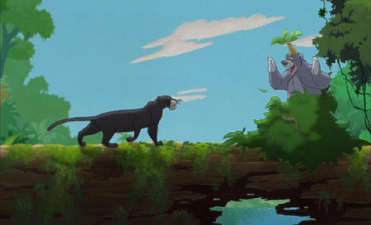
It’s a strictly Baloo-Mowgli adventure this time around, with the other characters serving as walk-ons and barely-there cameos. Bagheera is given practically nothing to do and he and Baloo never have the more grown up exchanges between themselves that peppered the first film and brought it depth. Likewise, Kaa the snake is only brought on a couple of times as a comic relief diversion (he shares a carbon copy scene from the first film with Shere Kahn), and Colonel Hathi’s elephants literally walk through the picture with no intention of ever slowing down or moving on the plot. The vultures are also back (the film does seem like a curtain call overall for the principles from 1968), this time joined by the aptly named Lucky (voiced, bizarrely, by Phil Collins – sorry, wrong jungle, pal!), who appears to fall prey to Shere Kahn in one scene, only to reappear much later alive and well, for no apparent reason.
There are a number of plot faults and open endings throughout the film, not least the fact that the humans seem to perfectly understand what the animals are saying (something that was cleverly not dealt with in the first film). It’s acceptable that Mowgli interact with Baloo and Bagheera as he was raised in the jungle among them, but for Shanti and Ranjan to simply open their mouths and for the animals to speak English back to them is never explained, even in a roundabout Pocahontas mythical-jungle-spirit-type way. This being so, couldn’t the humans just sit down with Shere Kahn (especially being British) and basically talk things through?
Steve Trenbirth, a personable enough fellow previously responsible for directing the animation on Lion King II: Simba’s Pride and Lady And The Tramp II: Scamp’s Adventure (two of the better DTVs) is here upgraded to sole director. He seems to have been able in the past to grace these films with the respect that the originals deserve, but on Jungle Book 2 it seems the rest of the crew were going off in their own directions.

One thing that really annoyed me was the simple matter of Baloo’s coloring. He’s not called Baloo because he’s b-lue, and he should be shown as he was in 1968, as a grey bear. Here he’s a pastel shaded big blue bear, even becoming purple in the big W-I-L-D sequence. What’s THAT all about? The featurette on the disc tries to provide an “answer”, but it’s a dubious decision at best!
By the end of the movie, I was struck at how strange the whole experience felt to me. I hadn’t felt any of the emotions that I had felt during the first film, but yet had experienced them all the same. It was if I’d been served a strong memory, but it wasn’t quite the way I remembered it, and inevitably not as good. Set in the ruins, the climax of the film suddenly introduces a stream of hot lava (volcanoes…out here?) and reaches silly proportions when characters leap ridiculous lengths and plummet to their apparent doom, only to survive seconds later. Shere Kahn doesn’t even get a decent death scene, being trapped by a falling statue, supposedly so he can presumably come back again in either Jungle Book 3 or whatever new TV series the Studio dreams up (I guess we shouldn’t mention Jungle Cubs), although when “The End” appears on screen, I just hope it really is!
The movie also wants to have its cake and eat it too, for even when Mowgli finally returns to the man village and is taken in by his adoptive father (John Rhys-Davies, who really ought to know better), he and Shanti still concoct a plan to sneak into the trees to play with their jungle pals. This ending, like the film on the whole, is indicative of what The Jungle Book 2’s main problem is: the lack of being able to be its own film, or rather a slave to the untouchable original. Thus we get the “two endings”, one of which ends quite satisfactorily in the man village and one which harks back to the first film and leaves us all on an up-beat, albeit a completely shallow up-beat.
A strange film to try and place specifically, its only real reason for existence is to expand The Jungle Book franchise and add to the DTV coffers (a sad fact is that more people saw this in theaters than saw Treasure Planet, but I bet the ratio of disappointed customers was a lot higher for this). That being said, the characters are fun to hang out with again, and despite the shortcomings, the target kids audience won’t know or care about the differences between the films, though four renditions of The Bare Necessities is enough for anyone! I’d suggest a rental for those fans who are mildly interested, though Disney die-hards will probably want to add it to their collections anyway, and at 72 minutes (65 not counting the credits) it’s a bright, but very breezy, way to spend some more time in the jungle, even if it is a bad case of strong “déjà vu”.
Is This Thing Loaded?
As with the film itself, the DVD contains new material as well as an overbearing nod back to the 1968 original, a strange situation that only shows up the differences between the two. Playing the disc for the first time, we’re shown the usual Sneak Peeks for upcoming Disney releases. Here, and from the menu, you’ll find previews for The Lion King Platinum, the Brother Bear teaser, the poorly animated Piglet’s Big Movie and Stitch The Movie, a live-action George Of The Jungle 2 teaser, Sleeping Beauty SE, Kim Possible, Air Bud Spikes Back, and two new Recess releases. Best of all, though it’s just a teaser, is a look at the live-action blockbuster The Haunted Mansion, starring Eddie Murphy

On to the Bonus Features proper and Mowgli’s Jungle Ruins Maze game. Not much fun for adults, this requires the player to help Mowgli through a 3D maze created in the style of King Louis’ ruins and back to the safety of the man village. I gave up halfway through, so can’t reveal whether there is anything worth waiting around for, though recent Disney games haven’t led to any exciting new footage or such, so I wouldn’t hold out much hope.
Of course, with the original not being currently available on DVD (ahem!) certain viewers will need a primer to gear them up for this new feature film. Although the opening credits serve up a brief outline, the Synopsis Of The Original Movie The Jungle Book expands a little further and does just that, presenting a three-minute narrated montage of the first film’s plot.
The Song Selection/Sing With The Movie features are both one and the same, presenting the film with an added subtitle track that activates and highlights the song lyrics throughout. Sing With The Movie appears throughout, while the Song Selection allows instant access to the various songs in the movie. Both use the same subtitle track.
Keeping with the songs in the film, there are also three “music videos” included, which are slight to say the very least! Merely commercials (lasting less than a minute each) for the CD soundtrack, both the W-I-L-D and Jungle Rhythm options are just the sequences from the movie, while the much-advertised Smash Mouth contribution, I Wanna Be Like You, features the band performing intercut with images from the movie. Clearly a commercial, the “Rated G” logo appears right at the end, and the song is a pointless inclusion in both the film and this disc. With no links to the movie’s story (it’s not actually featured in the film, but the Smash Mouth version plays over the end credits) this track really belongs on the DisneyMania album of contemporary artists’ Disney song covers, where it originated.
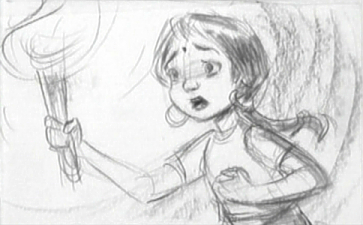
More music is to be found in the Deleted Scenes section, a much more worthwhile look at early concepts that didn’t make it to the final film. It says much for the corporate-committee style of making these films when the director isn’t allowed to voice his own opinions, and instead here the “senior vice president of music” Matt Walker and Sharon Morrill, “executive vice president” take to the screen to explain the cuts. Two deleted scenes are presented, both songs. I Got You Beat was an exchange between Mowgli and Shanti that was cut when the producers decided it set Shanti up as a too strong a character (something the film actually needed). In explaining why Shanti was made more ineffectual one does get the feeling that Morrill is actually justifying the decision to herself all over again, while Walker goes to great lengths to point out that these are temp tracks and rough vocals to storyboards.
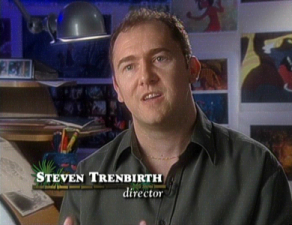
Another reason for the deletion of I Got You Beat might have been its length (it’s way too long) and the fact that it is simply not a good enough song. Much better is Braver, the second song cut from the film, which was to be sung by Shanti during her search for Mowgli in the jungle. Deleted to focus more on Mowgli himself, it wouldn’t be hard to picture this (with a little more work and full orchestra score) in a full-blown Disney feature. The end credits feature another song, Right Where I Belong, which I would imagine was destined for a place in the movie before being cut, but it is not present here. As they are, this deleted footage is well worth inclusion and adds up with the introductions to around nine and a half minutes.
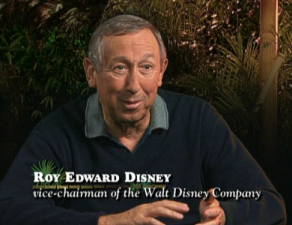
The best of the bunch regarding the extras is the 14-minute The Legacy Of The Jungle Book featurette. Fairly in-depth for a release like this, the mini-documentary takes in a look back at the original movie as well as the making of the new one. We hear from the team involved in the production and the reasons for the decisions made in updating the characters and the differences in animation techniques (though Baloo’s b-lue makeover still doesn’t wash). While technology has obviously allowed for “better quality” animation, it is strange to see, when they show a split screen of Shere Kahn prowling through the jungle from then and now, that the power of the older material is still so much stronger than the new! But this is a fine enough peek behind the scenes, and it can only be a good thing to set up anticipation for the release of the original Jungle Book at some point as the Platinum edition it is destined to be on DVD.
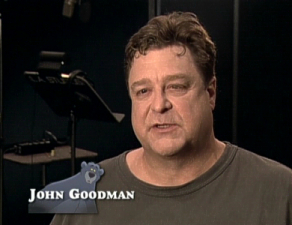
Case Study:
It seems following the release of The Rescuers that Disney has started to drop the traditional chapter index card usually found within their DVD cases, which seems a poor cost-cutting exercise. Do it on the secondary releases and DTV titles, by all means, but the classics and even theatrical sequels like this (which itself is an important release in Disney’s own eye) at least deserve a list of chapter titles. Cheap.
Ink And Paint:
Given a theatrical release, The Jungle Book 2 appears on disc in its original 1.66:1 anamorphic widescreen ratio and it’s fair to say that this digital-to-digital transfer looks great. A little too great in fact, and when placed against clips from the original film, the cleanliness of the new film’s image only shows up the lack of real depth in its actual animation. Blown up to a big screen this retains a strong bold image, but also wipes away some of the clinical aspects. No compression artefacts disturb the image, and overall this is as good as one might expect from a film of this type.
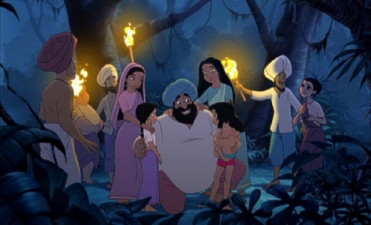
Scratch Tracks:
As with Disney’s previous DTV release of 101 Dalmatians II, this Jungle Book sequel is presented with a strong DTS track worthy of any theatrical release. While not full-on demo material, your set up will get a work out and the bass woofer works overtime in some sections. The standard Dolby Digital 5.1 is no slouch either, with slightly less separation across the front speakers, but with all the depth of the DTS. Not too much difference between the two, and more than adequate mixes. A similar French 5.1 Dolby track is also supplied, as well as English subtitles.
Final Cut:
The image is too “clean”, the animation lines too fine, and the story too flat, but in all other respects, it really is The Jungle Book…again. Kids will no doubt lap this up, especially with all the “boring, non kids stuff” from the first film thrown out and the new, “bouncy kid-friendly” Baloo thrown in. Adults may find they are not totally numbed completely by the movie’s end, but fans of the original will be disappointed and aficionados in general will be asking why the money put into these films can’t be spent on nurturing new talent with new stories to tell. I guess these films do at least train up the animators of tomorrow, but it’s a sad day when mainstream studio animation all seems to be going CG and the best of the 2D stuff is a selection of DTV sequels.
The Jungle Book 2 acts like a “best of” from the first film, a highlights show that doesn’t dare to include anything other than happy thoughts. As a movie, it’s fine for kids, but there’s no denying that this should have gone straight to video rather than the theatrical route. The space would have been left open for the Piglet movie that came out a month or so later, though even that film (so far the least enjoyable Pooh film) would have done best going direct to video, as the Studio ended up creating competition with itself and caused low returns. Not the best secondary Disney title that I’ve seen, but infinitely better than some of the others, The Jungle Book 2 is certainly worth a look, even if only for its curiosity value.
 | ||
 |








